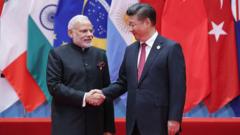

India and China are navigating a complex path as they attempt to reset their relationship, characterized by cautious optimism and persistent challenges. Following a period of heightened tensions, both nations are signaling a desire for stability and improved relations, but significant hurdles remain.
Recent Diplomatic Overtures
In late 2024, a border agreement between India and China led to a meeting between Prime Minister Narendra Modi and President Xi Jinping, the first since 2019. This high-level political engagement provided the necessary impetus to finalize military disengagement in Ladakh and restore regular dialogue on border management. Since then, several high-level meetings have taken place, including discussions between the foreign ministers and defense ministers of both countries. In early 2025, India and China agreed to resume direct flights between the two countries after nearly 5 years. These diplomatic efforts signal a thaw in relations, with both countries expressing a willingness to move towards a more stable and predictable path.
Economic Engagement
Despite the political tensions, economic ties between India and China remain crucial. China is India's largest trading partner, with bilateral trade crossing US$100 billion in the 2023-24 financial year. In 2023, bilateral trade reached a record US$136.2 billion, a 1.5 percent increase from the previous year. While trade volumes have grown, India faces a significant trade deficit with China, reaching $99.2 billion in 2024-2025. This has led to concerns in India about the growing dependency on Chinese goods. Both nations are now exploring ways to address the trade imbalance and enhance economic cooperation. China has expressed its readiness to import more Indian goods and provide a level playing field for Chinese enterprises operating in India.
Border Disputes and Security Concerns
The most significant impediment to a completereset of ties remains the unresolved border dispute along the Line of Actual Control (LAC). The violent clash in June 2020 significantly strained relations, and while some disengagement has taken place, both sides maintain a strong military presence in the region. India insists that peace and tranquility on the border are essential for the overall development of bilateral relations, while China seeks to decouple border issues from the broader relationship. This difference in approach poses a major challenge to normalizing ties. Furthermore, China's growing engagement in South Asia and the Indian Ocean region remains a key security concern for India.
Cautious Steps Forward
Despite these challenges, both India and China are taking cautious steps to improve relations. These include resuming religious pilgrimages to Tibet, sharing data on trans-border rivers, and facilitating media exchanges. Both sides are also preparing for the 24th Meeting of the Special Representatives on the India-China Boundary Question, indicating a commitment to finding a resolution to the border dispute.
The Path Ahead
The India-China relationship remains a complex balancing act. While both countries recognize the importance of稳定their ties, deep-seated differences and strategic competition persist. The path ahead will require sustained dialogue, mutual respect, and a willingness to address each other's concerns. Whether India and China can successfully navigate these challenges and build a more stable and cooperative relationship remains to be seen.